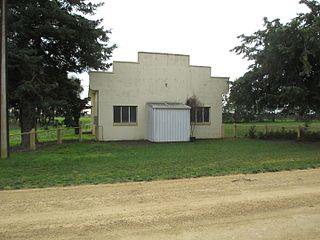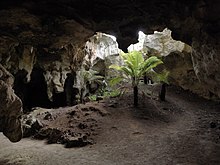
Protected areas of South Australia consists of protected areas located within South Australia and its immediate onshore waters and which are managed by South Australian Government agencies. As of March 2018, South Australia contains 359 separate protected areas declared under the National Parks and Wildlife Act 1972, the Crown Land Management Act 2009 and the Wilderness Protection Act 1992 which have a total land area of 211,387.48 km2 (81,617.16 sq mi) or 21.5% of the state's area.

The Limestone Coast is a name used since the early twenty-first century for a South Australian government region located in the south east of South Australia which immediately adjoins the continental coastline and the Victorian border. The name is also used for a tourist region and a wine zone both located in the same part of South Australia.

Riversleigh World Heritage Area is Australia's most famous fossil location, recognised for the series of well preserved fossils deposited from the Late Oligocene to more recent geological periods. The fossiliferous limestone system is located near the Gregory River in the north-west of Queensland, an environment that was once a very wet rainforest that became more arid as the Gondwanan land masses separated and the Australian continent moved north. The approximately 100 square kilometres (39 sq mi) area has fossil remains of ancient mammals, birds, and reptiles of the Oligocene and Miocene ages, many of which were discovered and are only known from the Riversleigh area; the species that have occurred there are known as the Riversleigh fauna.
Hacks Lagoon Conservation Park is a protected area in the Australian state of South Australia located in the locality of Bool Lagoon about 24 kilometres south of the municipal seat of Naracoorte.

Bool Lagoon Game Reserve is a protected area located in the Limestone Coast region of South Australia, about 24 kilometres south of the town of Naracoorte.
Fairview Conservation Park is a protected area in the Australian state of South Australia located in the gazetted locality of Woolumbool about 17 kilometres (11 mi) north of Lucindale in the state's Limestone Coast region.

Horsnell Gully Conservation Park is a protected area in the Australian state of South Australia in the locality of Horsnell Gully located about 9 kilometres (5.6 mi) east of the state capital of Adelaide and about 2.3 kilometres (1.4 mi) southwest of Norton Summit.
Australian Fossil Mammal Sites is a combined listing in the UNESCO World Heritage Sites for two places in Australia known for their extensive fossil remains.

Blanche Cave, previously known as "The Big Cave", "The Old Cave" and "Mosquito Plains Cave", is one of 26 caves to be found in the Naracoorte Caves National Park, a World Heritage listed site. Blanche Cave was the first of the caves to be discovered in the Naracoorte area, having been found by European settlers in 1845, and can be accessed by the public through guided tours of the site. The cave contains a number of features, including, at one time, the mummified remains of an indigenous man – remains that were stolen twice in 1861 and never returned. The location has been the site for a number of events, such as, in the early days, annual New Years parties and, much more recently, it was featured as part of the Olympic torch relay for the 2000 Summer Olympics in Sydney. Blanche Cave, along with the nearby Victoria Fossil Cave, was added to the South Australian Heritage Register in 1984.
Ferguson Conservation Park, formerly Ferguson National Pleasure Resort and Ferguson Recreation Park, is a protected area in the Australian state of South Australia located within the Adelaide metropolitan area in the suburb of Stonyfell, about 6.5 kilometres east of the Adelaide city centre.
Nilpena Ediacara National Park, which includes the former Ediacara Conservation Park, is a protected area located in the northern Flinders Ranges, in the state of South Australia. It is located about around 551 km (342 mi) north of the city of Adelaide, around 30 kilometres south-west of the town of Leigh Creek in the state's Far North.
Mullinger Swamp Conservation Park is a protected area in the Australian state of South Australia located in the state's south-east in the gazetted locality of Kybybolite on the border with the state of Victoria about 25 kilometres (16 mi) north-east of Naracoorte.
Grass Tree Conservation Park is a protected area in the Australian state of South Australia located in the state's Limestone Coast in the gazetted locality of Cadgee about 17 kilometres (11 mi) north of the town centre in Naracoorte.
Big Heath Conservation Park is a protected area in the Australian state of South Australia located in the gazetted locality of Spence about 20 kilometres (12 mi) south-west of Naracoorte in the state's Limestone Coast region.
Mary Seymour Conservation Park is a protected area in the Australian state of South Australia located in the south-east of the state in the gazetted locality of Bool Lagoon about 25 kilometres (16 mi) south-west of the town centre of Naracoorte.

Joanna is a locality in the Australian state of South Australia located in the state's south-east within the state’s Limestone Coast region about 325 kilometres south east of the state capital of Adelaide, about 19.5 kilometres south-east of the municipal seat of Naracoorte.

Dingley Dell Conservation Park is a protected area in the Australian state of South Australia located in the state's south east in the gazetted locality of Port MacDonnell about 4 kilometres (2.5 mi) north-west of the town centre of Port MacDonnell and about 26 kilometres (16 mi) south of the city centre in Mount Gambier.
Glen Roy Conservation Park is a protected area located in the Australian state of South Australia in the locality of Glenroy about 323 kilometres (201 mi) south-east of the state capital of Adelaide and about 25 kilometres (16 mi) north of the town of Penola.
The Knoll Conservation Park is a protected area located in the Australian state of South Australia in the suburb of Crafers West in the Adelaide Hills state government region about 12 kilometres (7.5 mi) south-east of the state capital of Adelaide and about 1.5 kilometres (0.93 mi) west of the town centre in Stirling.
Jip Jip Conservation Park is a protected area in the Australian state of South Australia located in the state’s south-east in the gazetted locality of Marcollat about 223 kilometres (139 mi) south-east of the state capital of Adelaide and about 50 kilometres (31 mi) north-east of the municipal seat of Kingston SE.










